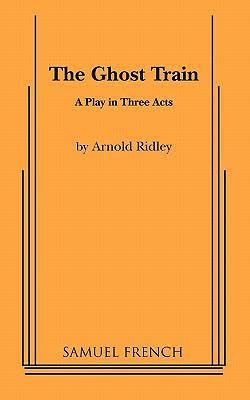7.2 /10 1 Votes7.2
Originally published 1927 | 3.6/5 Goodreads | |||||||||||||||||||||||||||||||||
 | ||||||||||||||||||||||||||||||||||
Similar Peril at End House, When We Are Married, Vampires Rock, Confusions, See How They Run | ||||||||||||||||||||||||||||||||||
The Ghost Train is a theatre comedy suspense thriller, written in 1923 by the English actor and playwright Arnold Ridley.
Contents
- Background
- Original cast
- Plot summary
- Production
- Film and broadcast adaptations
- Books
- Opera
- Other cultural influences
- References
The story centres upon the social interaction of a group of railway passengers who have been stranded at a remote rural station overnight who are increasingly threatened by a latent external force, with a reveal denouement ending.
The play ran for over a year in its original sold out London theatrical run, and is regarded as a modern minor-classic. It established the 20th Century dramatic genre of 'strangers stranded together in a railway scenario in constrained circumstances' thrillers, leading to films such as The Lady Vanishes (1938), Night Train to Munich (1940).
Background
Ridley was inspired to write the play after becoming stranded overnight at Mangotsfield railway station (a now lost station on the defunct Midland Railway Company's main line), during a rail-journey through the Gloucestershire countryside. The deserted station's atmosphere, combined with hearing the non-stop Bath to Gloucester express using an adjacent curved diversionary main line to by-pass Mangotsfield, which created the illusion of a train approaching, passing through and departing, but not being seen, impressing itself upon Ridley's senses. The play took him only a week to write. After a premiere in Brighton, it transferred to London's St Martin's Theatre, where - despite underwhelming reviews from the theatre press critics - it went on to play to sell-out audiences from November 1925 to March 1927.
Original cast
Changes to the cast during the run included Sydney Fairbrother (from June 1926) as Miss Bourne, succeeded in the role by Connie Ediss in November 1926.
(Ridley himself played Saul Hodgkin, the station master, in several productions over many years. He told The Guardian in 1976 that when he first played the part he had to make up carefully to look old enough, but latterly "I had a job to make myself look young enough").
Plot summary
The plot revolves around a party of assorted railway travellers who find themselves stranded in the waiting room of an isolated country station in the evening. The Station Master tries to get them to leave the site as he is closing the station for the night. At their reluctance to go and after they've refused his order citing the lack of alternative accommodation for themselves for several miles, he warns them of a threat if they remain from the supernatural danger of a spectral old railway carriage train, the ghost of one that fatally wrecked in the locality several years before, that sometimes haunts the particular line they are now on at night, which brings death upon all those who set eyes upon it. Incredulous of his story they still refuse to leave, and he departs leaving them facing a night on the station.
The main body of the play is then taken up with the interaction of the varied assortment of the passengers, being strangers thrown arbitrarily together in the odd social intimacy of happenstance that rail-travel involves, representing a cross-sample of English 1920s society, amidst a variety of escalating dramatic incidents combined with a heightening level of tension as the latent threat of the spectral train's, will it/won't it, appearance is ultimately dramatically realized, bringing as foretold disaster and death to the group.
The story then resolves from a socio-suspense drama into a spy adventure, when it is revealed that the train in question is quite real and is being used for smuggling illegal fire-arms into England by Soviet revolutionaries, and the story of the "ghost-train" has been concocted to scare potential witnesses away from the scene of the operation. A British Government secret agent incognito in the stranded passengers' midst is then revealed, who confronts the revolutionary gang in a gun battle on the station, and the revolutionaries' covert operation is defeated.
Production
In its first run in London, for its climactic moment elaborate special-effects utilizing visual and audio devices were used to create the sensation of a train passing close by on the stage at high speed, including garden-rollers running over wooden laths, thunder sheets, etc. Reviewing the premiere in The Manchester Guardian, Ivor Brown wrote, "the gentleman in charge of 'Noises off' becomes at times the protagonist, ... he can make a noise so like a train that he might impose on the station master of a terminus; meanwhile, he can throw in a hurricane, as it were, with the other hand."
Film and broadcast adaptations
Books
A novel based upon the play entitled The Ghost Train was published in 1927.
Opera
A chamber opera based upon the play entitled "The Ghost Train" debuted at the Carolina Chamber Music Festival in New Bern, North Carolina, U.S.A., in September 2012, scored by Paul Crabtree for six singers and an instrumental ensemble. In February 2016, it was performed by the Peabody Chamber Opera in the roundhouse of the B&O Railroad Museum in Baltimore, Maryland.
Other cultural influences
The popular British fairground attraction "Ghost Train" rides are named after the play.
